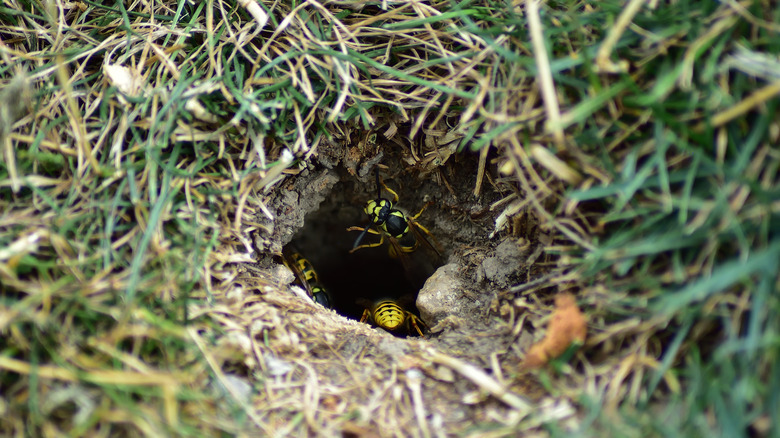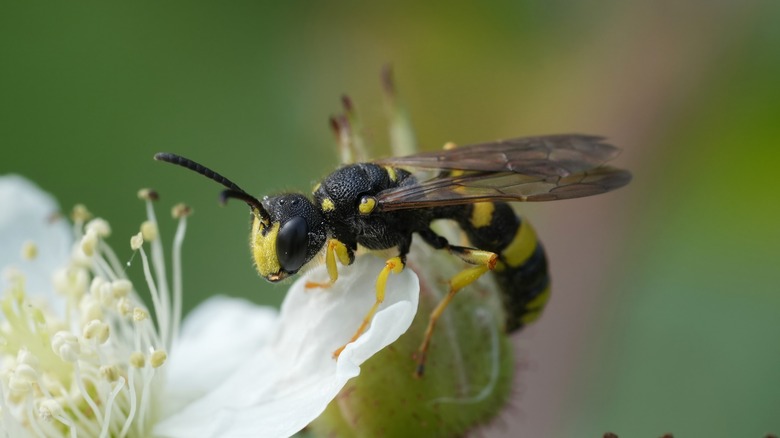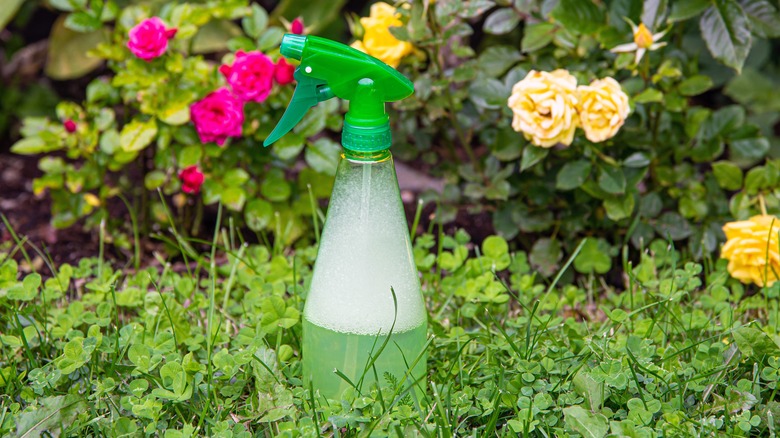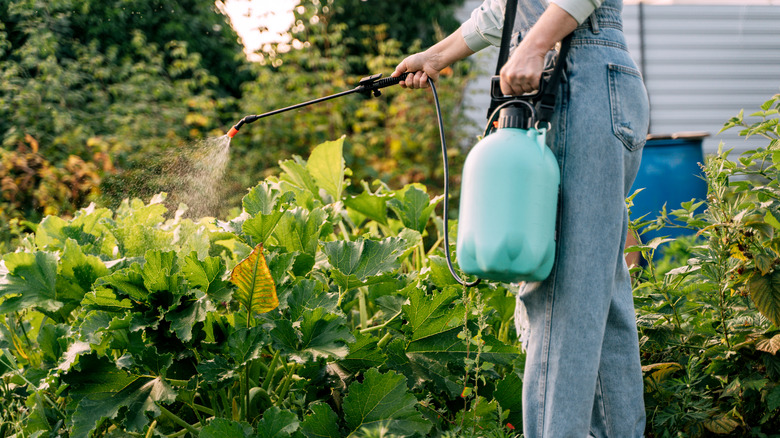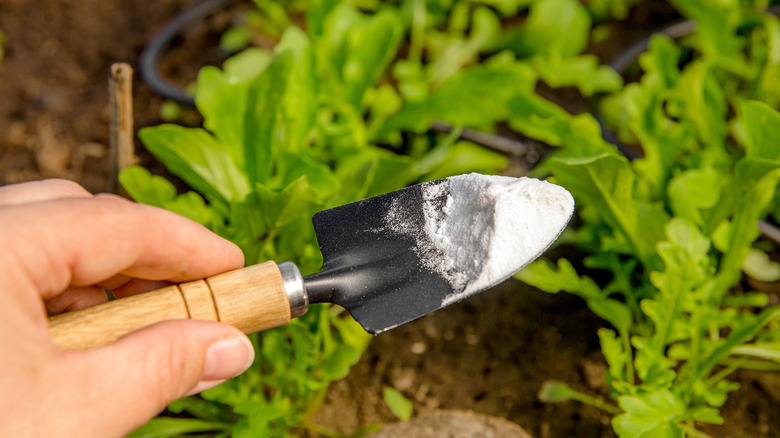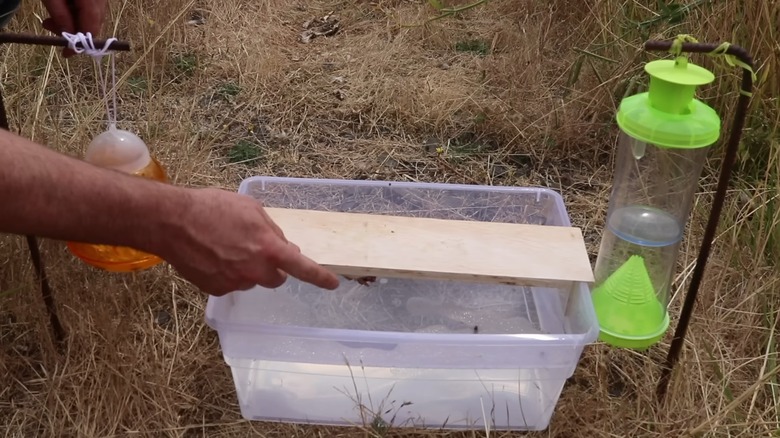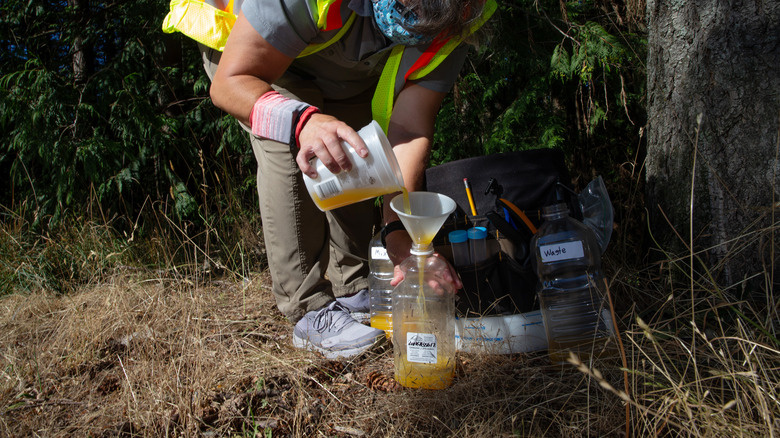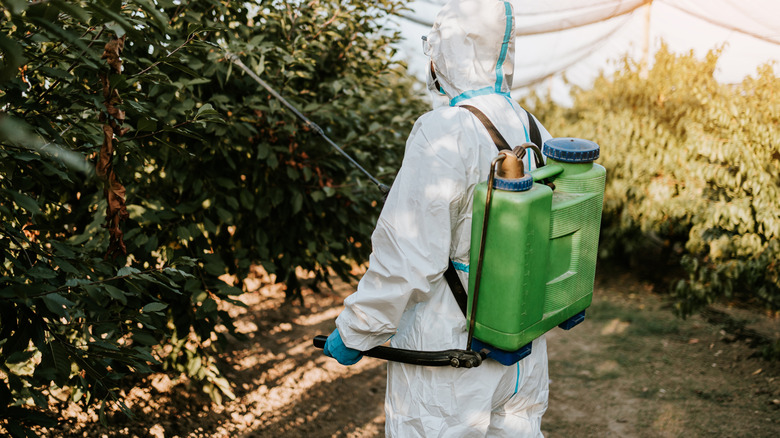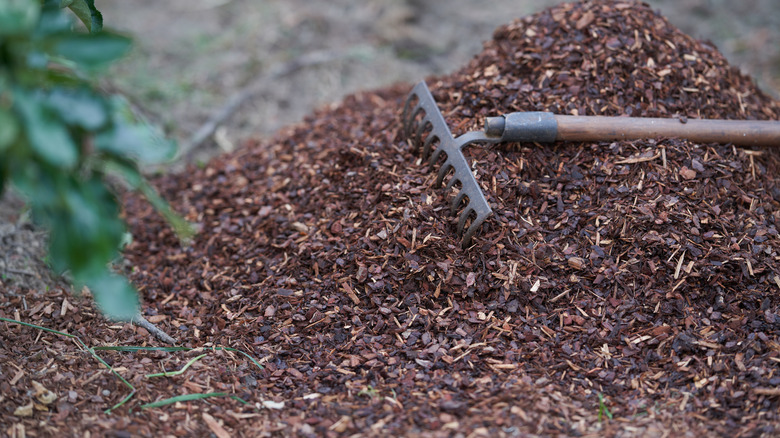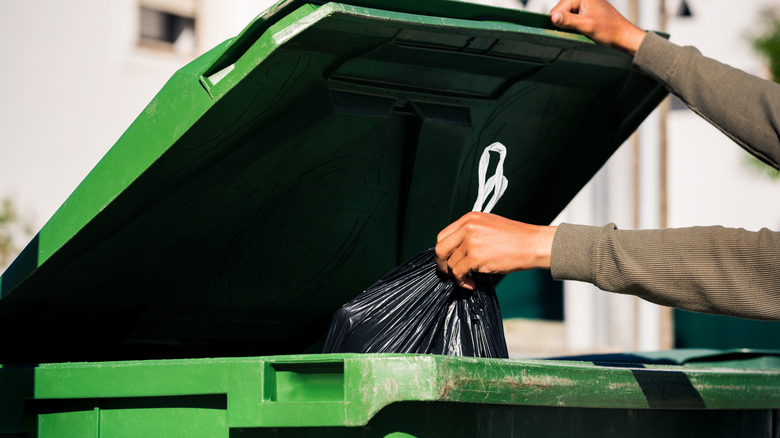Say Goodbye To Pesky Ground Wasps With These Essential Tips And Tricks
We may receive a commission on purchases made from links.
It's never fun to find a ground wasp nest in your backyard. These pests get angry and territorial when their nest is threatened, and merely walking near the hive can be interpreted as an assault. This can spur on an attack that can result in painful stings. As you can imagine, having such a nest reduces the enjoyment of your backyard, and makes you wary of letting curious pets and children roam the garden freely. The mere nuisance is certain to convince you to take action to get rid of these aggressive pests. So, to take the pressure off as you navigate your wasp eradication journey, here are several proven tips and tricks to eradicate them from your yard. These include dusting nests with insecticide, baiting wasps into traps, and killing them with soapy water.
That being said, note that not all ground-nesting wasps are aggressive, and letting some stay is likely to benefit your landscape, as they aid pollination and prey upon pesky plant critters. So, unless they're homing within 20 feet of a high-traffic area, venturing into your barbecue spot, feeding on your late summer fruit crop, posing a danger to pets or kids, or buzzing around your trash cans, avoid taking action and allow the fall temperatures to freeze their population.
Identify the wasps or their nests
Before you gear up for Mission: Wasp Annihilation, ensure you know what you're up against. Heaps of harmless bees and wasp look-alikes are often misidentified due to their similar stripes and shades. Even their nesting hives and burrows appear similar, although wasps tend to dig homes with larger openings unless skunks have shaved them down — a rare instance when you might appreciate their presence and tolerate their stink.
Moreover, it's important to note that "ground wasp" is a blanket term that covers a variety of solitary and social wasps, each requiring different treatments. Solitary digger and thread-waisted wasps, for instance, are less of a concern as they tend to keep to themselves, tunneling new homes in dry soil and remaining reclusive until their offspring arrive. This means that taking action against them might not be cost-effective.
On the other hand, social wasps like yellow jackets, with their caste-driven colonies with queens and workers, are the ones to be wary of. They're highly aggressive when defending their territory or stealing nibbles from your picnic table, and can launch into an attack if they feel threatened. You're likely to find them house-hunting around abandoned animal burrows, cavities, rotting tree stumps, untamed grasses, or soft soils as the spring verges on summer. If you're uncertain which version you have, BugGuide or your local extension service can often help with ID.
Wet and obliterate wasp populations with soapy water
One of the easiest ways to remove wasps from the premises is to use soapy water. Combine liquid soap and water in a 1:1 ratio in a spray pump like the Munyonyo Garden Pump Sprayer. This will give you a further and more powerful reach than a simple spray bottle. Then, douse the nest's entrance, coating the pests inside with soap. While this works wonderfully for exposed nests such as those built on eaves or in shed corners, using a spray pump might not be as effective for an underground nest. That's because the spray might not reach every tunnel and den to kill those inside. For better results, use a large watering can filled with soapy water. Make sure it has a long spout to ensure there is some distance between you and the nest, and pour it directly into the entrance, flooding the colony. Follow up this treatment with a kettle of boiling water, killing those that might have survived.
The reason this easy hack works to get rid of wasps is that the soapy water floods their respiratory system, suffocating them. While you can use this on most wasps, you want to tread carefully if targeting a large nest. These can be more difficult to manage, especially if the wasps begin to swarm. To stay on the safe side, enlist the help of a family member or friend and add a wet/dry vacuum into the mix. Fill the canister with soapy water as a trap, and have them point the hose at the entrance. If some angry wasps fly out after the colony is doused with soapy water, they will be sucked into the vacuum and straight into the trap. However, this is best for nests with only one entrance. If it has more than one, you will need to point a hose at each access point, which might require extra helpers.
Note that if you're dealing with a particularly large nest, you should skip this trick and instead use a commercial insecticide. Soapy water wouldn't be sufficient to destroy a large, well-established colony. While you would have to skip the spray pump, you can employ the wet/dry vacuum trick alongside the insecticide.
Treat the wasps with aerosol sprays
If you want something stronger than soapy water, you can also consider using an aerosol insecticide spray. However, this method isn't as effective as using an insecticidal powder when removing ground nests (more on that in a minute.) Instead, aerosol sprays are best used for exposed nests. That's because you don't know how big the underground nest is, or how far and much you have to spray to kill the entire colony. But if you have some leftover spray from targeting paper nests from the year before and don't want to buy another product, it might be worth trying. Just know that you will get better results using other methods on this list.
For best results, use the spray either during the early morning or evening, which is when wasps are less active. This will lower the risk of them swarming and stinging you. However, you still want to prepare yourself for possible stings, so wear protective gear that consists of full sleeves, long pants, boots, and rubber gloves. That being said, start with sprays labeled "caution" because they imply the least toxicity. But if they don't work, skip ahead to aerosols signaling "warning," which is the next level up. You also want to choose a product containing active ingredients ending in -thrin, like permethrin or cyfluthrin. These ingredients stun and kill the pests more quickly than other ingredients, which is a bonus when dealing with aggressive flying insects.
Add insecticidal dust at the nest's entrance
For better results, use insecticidal dust over aerosol sprays. Grab any permethrin-based or carbaryl-based insecticide dust like Sevin off the hardware store shelves. Using a bulb duster like Dr. Killigan's Insect Buster, layer the insecticide dust thinly at the underground lair's entrance after dusk. Also pour some directly inside the hole. Monitor the colony for a few days, and reapply if you still see some wasps flying in and out. Once you've confirmed no wasps are climbing out, seal the nest with soil.
This works because unsuspecting wasps carry the granular coup de grace back to their colony, infecting others until the whole colony perishes. As they walk around the entrance hole, the dust sticks to their legs, and they bring it deeper into the colony. Then, as the pests groom themselves, they ingest the granules and die. However, this method is best used if you have a larger ground nest with one entrance. It's not very effective if you have several smaller nests with multiple holes.
Use a trap to remove yellow jacket wasps
If you're nervous about approaching ground nests, one way to get rid of wasps is to trap them. However, this method is a bit of a hit or miss. It's best employed if you want to reduce the wasp population in your backyard, but it won't kill off the entire colony. Because of this, it's best used in conjunction with insecticidal dust, since it will lower the amount of wasps you will need to eradicate. But that's not the only caveat. For this to work, you also need to figure out what kind of wasps you're dealing with. For instance, if you want to use commercial traps with heptyl butyrate (the most common type), you'll only be able to catch western yellow jackets since the chemical doesn't work on any other species. However, if you have eastern or German yellow jackets, setting a trap consisting of fresh meat, water, and soap might be able to help, but it's not guaranteed. If you have a different wasp species in your yard, skip this trick, as traps aren't likely to help.
To DIY a lure, grab a clear container. Nail a piece of chicken meat to a block of wood and flip the block upside down on the container. Next, add water until it's 1 inch short of the bait and add dish soap. If all goes well, the wasps will touch the water as they try to access the chicken, and the dish soap will break the surface tension so that they can't clamber out. Replace the chicken every day, as rotten meat won't attract wasps. Also, position the trap at your property's edges, near natural plants where they nest, to keep them from surrounding areas you like to relax in, like the patio. This strategy is most effective in early spring when the colonies are still establishing.
DIY fruit-juice baited traps during late summer or early fall
If meat does a poor job of ensnaring ground-nesting yellow jacket wasps, you might be using the trap during the wrong time of year. If you're combating wasps during summer's end or early fall,consider switching your bait to something sweet like fruit juice, grenadine, or even Mountain Dew. The reason? Yellow jackets do a turnaround on their food preferences, gravitating to sweet items, from soda pop and candy to the fruits ripening in your garden. That's also why they become a raging nuisance around your fruit trees.
To banish the ground wasps with a penchant for fruit, repurpose an old plastic bottle to create your DIY trap. Splice the top and fill the base with 2 parts, each of water and apple juice. Sweeten the liquid further with ½ cup sugar. Also, make space for 2 parts of apple cider vinegar — ground wasps can't stand this common kitchen cabinet staple. Finally, mix in dish soap since it works as a surfactant. Invert the cut top part into the bottle and place the trap in areas with a heavy infestation but beyond high-traffic areas. Alternatively, drill holes in the sides, pass a string through them, and hang the homemade trap from a fence. Replace the solution every three days or after rain to ensure the wasps continue to smell and are attracted to the fermenting water.
Know when to call the pros
Contacting a wasp exterminating company to eliminate the yellow jacket infestation on your property can cost you anywhere between $500 and $1300. So, it can be quite tempting to take charge of the whole process. However, calling in professional help is recommended if the situation has gotten out of hand. In other words, while you might still be able to handle the colony early in its reproduction season (usually spring), the risk will only magnify as the season progresses into summer. So, unless you've maintained your set of specialized tools and bee suits, handing over the problem to a pest control company will keep you from coming in harm's way — they have the equipment and the expertise.
Another circumstance where you should avoid treating ground wasp nests yourself is if you or anyone in your family is allergic to wasp stings. While it's common to develop an itchy, red welt right after a sting, it usually heals in a day. However, in the case of allergies, you'll likely experience nausea, diarrhea, wheezing, or even unconsciousness. Since taking the situation into your own hands isn't worth the toll on your or your loved ones' health, hire a professional pest control company.
Maintain your yard to keep wasps away
Eliminating your ground wasp infestation once doesn't ensure the control will last forever. If anything, their new gen will gladly return to your yard if the conditions remain conducive. To prevent that from happening, start inspecting your lawn for bare or thinly covered spots, as they present prime grounds to form burrows. Next, reseed the area to thicken the turf cover. But if it's not possible because of high traffic or poor growth conditions, swathe the area in mulch (read: wood chips) or plant fast-growing ground covers. This should even deter solitary diggers like cicada killers.
Concurrently, you also want to keep on top of abandoned burrows or cavities left behind by previous, uninvited intruders, aka rodents. That's because wasps prefer nesting in readily available homes as opposed to starting from scratch. So, wherever possible, particularly from spring through early summer, cover up any holes or burrows. When the nesting season kicks off, ramp up on using your lawn sprinklers, as ground wasps only excavate in dry soils. The wetness would key them in that this isn't the right location for their progeny.
Ensure sanitation and sealing
You should also address things that are attracting wasps to your home and garden. If their regular gatecrashing at picnic tables is any indication, yellow jackets will buzz in wherever they sense food, especially late in the summer when they fly far away from their homes in search of new food sources. Sadly, this also means pet bowls are highly unsafe outdoors during summer. Sanitation is key, as uncovered trash cans or recycling bins brimming with soda bottles and rotting fruit make for favorite wasp haunts. Because of this, remember to replace the lid every time you throw out the trash. If possible, add plastic liners to your trash cans and wipe them clean with soapy water on a consistent basis.
You'll also need to stem any water leakages. Although it might come across as contradictory, as it's advised to keep the soil moist to deny the stingers new territory, any practice carried out in excess can be detrimental. Simply put, your yard's dirt should be damp, not dripping wet, and water puddles are a strict no-no, especially in drought-ridden, peak summers when water becomes a hot commodity. Lastly, caulk all cracks and cavities before their nesting season begins in earnest to ensure your home doesn't become their domain.
